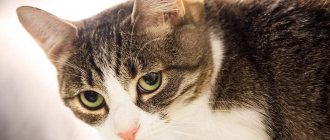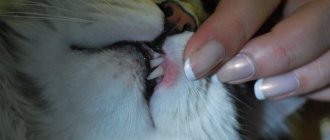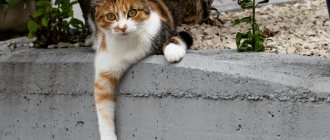Causes
The following irritants contribute to the occurrence of an autoimmune process:
- viral and bacterial infections;
- nephrotoxins;
- unbalanced diet;
- injuries;
- dampness;
- side effects of medications;
- neoplasms;
- kidney disease;
- dysfunction of the thyroid gland and adrenal glands;
- diabetes.
The occurrence of the disease is promoted by hypothermia as a result of bathing the cat.
recommended articles:
- Nephritis in cats
- What to do if your cat can't go to the toilet?
Bathing a cat can result in pyelonephritis
What are the dangers of kidney disease in cats?
For many cats with glomerulonephritis, the underlying cause remains a closely guarded mystery. In this case, we are talking about an idiopathic case of pathology. It should be noted that in the practice of veterinarians it happened that they identified kidney diseases associated with chronic poisoning. In particular, if the owners constantly feed their cat some cheap food, the manufacturer of which does not care too much about the quality of the product, anything is possible.
In addition, there is a high risk of developing glomerulonephritis in those cats that are initially predisposed to allergic reactions. The fact is that such animals have a very high risk of autoimmune diseases (they are often of allergic origin). So if your cat starts sneezing from every grain of pollen, take him to the vet more often!
Let us list the main reasons leading to disturbances in kidney function.
Dietary:
- Unbalanced diet (excessive consumption of protein, phosphorus, salts).
- Insufficient water intake when feeding dry food.
Traumatic:
- Falling from height.
- Getting hit by a car.
- Hypothermia, frostbite.
- Heatstroke.
- Compression of the ureters by tumors.
Infectious:
- Bacterial infections.
- Viral diseases.
- Undertreated and neglected diseases of the genitourinary system.
Poisoning:
- Rat poisons.
- Chemicals.
- Detergents
- Medicines.
Congenital:
- Renal dysplasia (developmental pathology).
- Renal aplasia (absence of one or two kidneys).
Risk group
Those at risk for kidney pathology are:
- Elderly cats and cats. By the age of 9 years, the likelihood of this type of disease increases by 2 times.
- Cats that are obese and lead an inactive lifestyle.
- Representatives of some breeds: Abyssinian, Somali, Himalayan, Persian cats and exotics.
- Animals kept in damp rooms and drafts.
- Underweight cats, starving animals.
Varieties
The following forms of glomerulonephritis are distinguished:
- membranous - capillary walls thicken;
- proliferative – neoplasms appear;
- mixed, the most severe.
The following types of glomerulonephritis are classified according to severity:
- manifest. Occurs suddenly and progresses rapidly;
- subacute The sluggish process is gradually intensifying. Goes into a permanent state;
- chronic. Continues for years, leading to the development of chronic renal failure and a “shrunken kidney.”
Glomerulonephritis
What is glomerulonephritis?
Glomerulonephritis is a kidney disease in cats that affects their glomerular apparatus. The inflammatory process develops against the background of damage to the glomerular structures. This may occur, for example, due to damage to the basement membrane by harmful bacteria. Due to some factor (such as cooling), an allergic reaction is triggered in the body, as a result of which immune complexes appear, to which complement attaches. These complexes settle on the membrane tissues, causing damage to the glomeruli. As a result, lysosomes are damaged, the coagulation system is activated, disturbances appear in the microcirculatory system, which leads to immune inflammation of the renal apparatus.
Symptoms
Acute glomerulonephritis lasts about two weeks, after which the cat recovers or dies, or the disease becomes chronic. The manifest phase is characterized by the following symptoms:
- depressed state;
- lumbar pain;
- difficulty emptying the bladder, oliguria or anuria
- hematuria;
- wandering swelling - in the morning on the back, in the afternoon on the paws;
- vomit;
- diarrhea;
- tachycardia;
- dyspnea;
- hypertension;
- fever;
- pulmonary edema;
- acute cardiac failure, convulsions, loss of consciousness;
- uremic coma, ending in the death of the animal.
The chronic course of glomerulonephritis is accompanied by a gradual failure of nephrons. When the percentage of affected glomeruli reaches 75, chronic renal failure (CRF) develops. Permanent glomerulonephritis occurs in the following forms:
- Nephrotic. Manifested by the presence of protein and blood in urine. Urine is released in limited quantities. Renal edema occurs. Touching a cat's back is painful.
- Hypertensive. Manifested by loss of appetite, vomiting, thirst, polyuria, progressive exhaustion. Due to high pressure, a stroke develops, accompanied by paralysis or retinal detachment with subsequent loss of vision.
- Hematuric. Protein and blood are found in the urine.
- Latent. It is asymptomatic and ends with chronic renal failure.
- Mixed. There are signs of all of the above forms.
Symptoms
The most common clinical symptom of glomerulonephritis is blood in the urine. But even more characteristic is the appearance of large volumes of protein in it (proteinuria). It should be especially noted that in some cats the last sign is the only symptom of the disease. More general symptoms of glomerulonephritis in cats are also very common, which include a sharp decrease in appetite and progressive emaciation of the animal. Polydipsia is also quite characteristic; intermittent vomiting is also very common. Approximately 70% of cats eventually develop chronic renal failure.
Diagnostics
A preliminary diagnosis is made by a veterinarian based on the results of an examination and anamnesis. To confirm, laboratory tests are prescribed, as well as instrumental studies.
Lab tests
The following tests are informative:
- Analysis of urine. Allows you to diagnose glomerulonephritis before the appearance of clinical symptoms;
- standard and biochemical blood assessment;
- identification of pathogens of infectious diseases;
- distillation of urine and blood proteins into fractions by electrophoresis;
- kidney biopsy.
Hematuria
Instrumental studies
The veterinarian prescribes the following additional diagnostic tests:
- abdominal radiograph;
- Ultrasound.
Videos and illustrations
"Chronic glomerulonephritis in dogs and cats", R. Leonard
Arterial hypertension with glomerulonephritis
Changes on ultrasound
Acute glomerulonephritis
Treatment
An important point is to ensure proper maintenance and adequate feeding. The cat's rookery is set up in a place where it is dry and there are no drafts. You cannot walk, brush, or massage your pet.
If the acute phase of glomerulonephritis is diagnosed, the animal is not fed for two days. Then they offer liquid food. If a felinologist does not know how to prepare a diet, it is better for him to use professional wet food for cats with kidney disease. Ready-made meals contain amino acids, minerals and vitamins necessary for recovery. Otherwise, you need to consult a veterinarian.
Medicinal food
Symptomatic treatment of glomerulonephritis is combined with antimicrobial treatment. To relieve intoxication, injections of glucose or magnesium sulfate are performed. In case of severe intoxication, bloodletting is practiced. Venous blood is allowed to flow through the needle into a graduated container. For an animal weighing 4 kg, it is necessary to remove 17...20 cm3. The procedure reduces blood pressure and stimulates hematopoiesis.
The veterinarian prescribes the following antimicrobial agents:
- Amoxiclav;
- Claforan;
- 5 NOK;
- Sulfonamides;
- Ceftriaxone;
- Palin.
To relieve inflammation, the veterinarian prescribes glucocorticosteroids, vasodilators, anesthetics, diuretics, and coagulants.
Cetrifaxone
Prevention
To prevent glomerulonephritis, you must follow these rules:
- Avoid bathing your cat unless absolutely necessary;
- carry out vaccinations against especially dangerous infections according to the vaccination plan;
- provide the cat with a dry, warm place to rest;
- organize a balanced diet with prepared feed or natural products;
- Conduct preventive examinations of the cat once every six months;
- monitor your pet’s behavior and prevent its contact with toxic substances and irritants.
Timely treatment of glomerulonephritis will avoid failure of the filtering glomeruli of the kidneys. The cat has a chance for a full recovery. When the disease becomes chronic, the felinologist must take care to maximize the life of the pet. Dietary nutrition, supportive therapy, and constant contact with a veterinarian are necessary.
We invite you to join our Zen channel and group on VKontakte or Odnoklassniki, where new articles for pet owners are published.
Similar articles:
- If your cat has food allergies
- Ringworm Caution: What Pet Owners Need to Know
- Why are cats overweight?
Glomerulonephritis in cats
Glomerulonephritis is a kidney disease characterized by damage to the glomeruli (glomeruli of the kidneys). Most often, this disease affects both kidneys at once. Thus, the filtering ability of the kidneys sharply deteriorates, which leads to blood and proteins entering the urine.
There are a number of factors that provoke the appearance of glomerulonephritis in cats.
- Viral diseases (leukemia virus, immunodeficiency virus, viral peritonitis)
- Worm infestation
- Neoplasia
- Pancreatitis
- Chronic bacterial infections in the lower urinary tract, etc.
Symptoms
Most often, clinical signs do not appear in the initial stages of the disease. In addition, symptoms depend on the severity of proteinuria (protein content in the urine).
If the protein content in the urine is moderate, then the symptoms of the disease are nonspecific. Body weight decreases, the cat becomes lethargic. With a more pronounced loss of protein in the urine and an increase in hypoalbuminemia (decreased albumin in the blood), the cat may develop peripheral edema and ascites. When the disease affects more than 50% of the nephrons, azotemia develops, renal failure, which is manifested by increased thirst, increased amount of urine, anorexia, vomiting, and blood in the urine. The disease is often complicated by pulmonary embolism, retinal hemorrhage or retinal detachment, which is manifested by sudden onset of shortness of breath and blindness.
Diagnosis of the disease includes a general clinical urine test (high protein content, sediment), urine protein/creatinine ratio, urine culture with antibiotic titration, biochemical blood test (decreased albumin and increased cholesterol), clinical blood test (anemia, leukocytosis). Ultrasound for diagnosing glomerulonephritis is not a specific method, but it helps to differentiate glomerulonephritis from pyelonephritis and kidney stones.
The most reliable method for diagnosing glomerulonephritis is a kidney biopsy, which allows one to accurately distinguish this disease from renal amyloidosis, however, it has a number of contraindications to its implementation.
Treatment of glomerulonephritis in cats should be aimed, first of all, at eliminating the causes of the underlying disease.
Sick animals are recommended to eat a diet high in quality protein. The standard treatment regimen for glomerulonephritis may include the use of glucocorticosteroids, diuretics, antihypertensive drugs, antispasmodics, and hemostatic agents. However, it should be understood that in each specific case only a veterinarian can decide on the advisability of using certain drugs. The article was prepared by Lagutina A.S.,
veterinary therapist at MEDVET © 2021 SEC MEDVET











